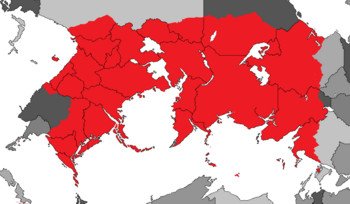Constantio Empire
Empire of Constantio | |
|---|---|
 The Constantio Empire at its height in 1766 | |
| Capital | Norasa |
| Establishment | |
• Establishment | 1591 |
• Dissolution | April 8th, 1827 |
| Population | |
• 1800 estimate | 226,000,000 |
The Constantio Empire was the imperial period of Constantio which lasted from 1591 until its dissolution in 1827. As a polity, it included large territorial holdings in Western and Central Nortua. At its height in 1766 under Justano IV, the empire ranged from eastern Beatavic, to around the Sotoa Sea, to the coast of the Besmenia Bay in Besmenia, and to the interior of Zoygaria. The empire was ruled by emperors, the first of which was Justano II and the last of which was Isidoros. The empire began with an initially diplomatic foundation, with the Treaty of the Tyrakri uniting kingdoms around the Tyakri River in Norasa, but was expanded throughout its history by a series of military conquests. The fall of the empire came in the 19th century with the Great Nortuan War, which consisted of many rebellions against imperial control. Due to the Constantio Empire's vast extent and relative endurance, the institutions and culture of Constantio had a profound and lasting influence on the development of language, religion, art, architecture, literature, philosophy, law, and forms of government in the territory it governed.
History
Founding
Facing a string of domestic tension from economic downturns and droughts impacting crop production, the king of Norasa, Justano I, called a meeting of regional warlords and patriarchs from neighboring towns and cities and proposed a unification of the Tyakri River valley kingdoms. The Treaty of the Tyrakri was ratified in 1572, and a Council of Administrators serving as a semi-democratic system established the Kingdom of Greater Constantio. As the benefits of a greater alliance and combined territorial control became clear, the Kingdom began preparations for further expansion. The Empire was founded in 1591 after Justano's son, Justano II, led a brutal conquest of Cechena. The title of 'king' was adapted to 'Emperor', and the Constantioan influence in Western Nortua began to grow prominently.
Expansion
The 1600s marked a consolidation of Constantioan power, as expansions were made in the conquests of Judsi, Ansion, and Achijan. The empire expanded dramatically in the 1700s when a series of conquests under Emperor Politari I in 1701 annexed Syraranto, Icadania, Vuswistan, Utobania, and further expansion in the decade following under Politari II resulted in conquests of Besmenia, and northeastern Birnir. The Empire became a dominant naval force, controlling the entirity of the Sotoa Sea.
The Constantio Empire began to make relations with other major powers at the time, including the Skithan Empire, the Elbresian Kingdoms, and the Vitaso Kingdom under Alexander Agostinio in the late 1700s. In the first half of the eighteenth century, the Constantio Empire came under increasing strain from inflation and the rapidly rising costs of warfare and expansion that were impacting both Constantio and the rest of their empire across Nortua. These pressures led to a series of crises around the year 1750, placing great strain upon the Constantioan system of government. The empire underwent a series of transformations of its political and military institutions in response to these challenges, enabling it to successfully adapt to the new conditions of the last half of the century and remain powerful, both militarily and economically.
The capital of the empire was moved in 1752 from Norasa to the newly created city of Apelnisse on the shore of the Sotoa Sea.
Decline

The Constantio Empire began to decline in the early 1800s, specifically during the Chezian Wars of Independence, sometimes referred to as the Great Nortuan War. They were a series of wars that marked multiple revolutions and secessions from the empire, including the Syraranto War of Independence (1811-18), the Vuswistan Revolutionary War (1817-21), the Icadanian Secession (1822), the Besmenian War of Independence (1815-1821), and the Utobanian War of Independence (1812-16).
The endless military defeats and the wide range of conflicts raging at the same time strained the Constantio Empire, and Emperor Isidoros declared the dissolving of the empire on April 8th, 1827 with the Armistace of Gurikans. Upon the dissolution of the empire, Emperor Isidoros took his own life, passing the still united but fragile alliance of Constantio to his nephew, King Adonis Kalliadis. The period in between the end of the empire to the establishment of the Republic, the Council of Administrators were frought with corruption and infighting as either establishment base attempted to sway the opinions of King Kalliadis.
Kalliadis was assassinated on March 26th, 1831, by a member of the Council of Administrators. As Kallidas had no heir and no relatives able to replace him, the Council held a vote to place Tasos Andrelis into the position of an interim administrator rule in place of the monarchy. Andrelis, in turn, was assassinated on December 1st, 1838, replaced again by a vote by Thomas Anagnoulis.
Geography
Politics
List of emperors
See also: Emperor of Constantio
| No. | Emperor | Portrait | Reign |
|---|---|---|---|
| 1 | Justano I | 
|
July 1572 - July 1586 |
| 2 | Justano II | 
|
July 1586 - August 1631 |
| 3 | Justano III | 
|
August 1631 - April 1640 |
| 4 | Patras I | 
|
April 1640 - March 1646 |
| 5 | Patras II | 
|
March 1646 - September 1659 |
| 6 | Vathy I | 
|
September 1659 - December 1681 |
| 7 | Patras III | 
|
December 1681 - May 1694 |
| 8 | Politari I | 
|
May 1694 - June 1708 |
| 9 | Politari II | 
|
June 1708 - May 1723 |
| 10 | Apelnisse I | 
|
May 1723 - August 1739 |
| 11 | Vathy II | 
|
August 1739 - March 1741 |
| 12 | Justano IV | 
|
March 1741 - November 12th, 1768 |
| 13 | Apelnisse II | 
|
November 12th, 1768 - May 13th, 1788 |
| 14 | Vonitsos | 
|
May 13th, 1788 - June 29th, 1804 |
| 3 | Isidoros | 
|
June 29th, 1804 - April 8th, 1827 |
